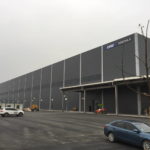
Describing Wärtsilä as the leading foreign player in China’s marine industry, Roger Holm, President Marine Solutions and responsible for Joint Ventures, talked to Michael Meyer about chances and challenges of building up cooperation projects there
In May, the Finnish technology company anno[ds_preview]unced a JV with China’s CSSC for automation. It is coming into operation during the second half of the year. It is actually Wärtsilä’s third JV with CSSC. There is another one, a new engine factory in Shanghai – the first to produce gas engines in China, Holm emphasizes, and there will also be a propulsion factory in Zhenjiang. Presenting an interim balance for the first time, he says: »I think we have chosen the correct timing because, of course, it is still in a starting phase, but we know the gas boom will grow, and in China as well. As being the only one producing dual fuel engines in China, we will have a big advantage.«
At the moment, Wärtsilä does not plan any further JVs, as Holm and his colleagues feel they have quite a good market coverage in China already since they operate six factories either owned or in Joint Ventures. Propulsion and engines as well as electrical automation are covered.
Last year, Wärtsilä sold its share in WinGD, another JV with CSSC. »First we owned the two-stroke business which is now called WinGD. Then we made up a JV because we realised that, in order to be successful, we needed a strong partner. And CSSC was a very good choice. But then, after some years, we concluded together with CSSC that actually it is better for them to operate it on their own. But they have also agreed that we take care of the global service business,« Holm explains.
When comparing it to a JV with Hyundai in Korea, he stresses that from an operational perspective »we run it in the same way, there is not a big difference. Because what the JV delivers is still a full Wärtsilä product like the ones coming from Europe or elsewhere. So we do the assembly together with our partners, but the big part of the supply chain and how we control the quality and how we produce it are Wärtsilä processes.« Some players use license models but the Finns abstain from this as they believe that by staying in conrol they can guarantee the client will receive Wärtsilä quality.
What about the main challenges of running a JV in China? Some people complain about bureaucracy. RogerHolm has »not really« made these experiences. For him, the challenges in a Joint Venture in China as well as in other places is to be sure you have a joint target together with your partner as well as definitions who brings what to the common project, and what will be the roles of each partner. »If you don’t define that right in the beginning, it will be challenging. Other than that, we haven’t really seen that putting up new companies in China would be more difficult than in other places.«
However, when talking and working with Chinese partners, he partly sees what people call different business cultures: »You see differences in doing business in all places, China being one of them. But again, I don’t see a big difference to other locations.«
In various industries, some analysts warn of the loss of knowledge when cooperating with Chinese players. However, at Wärtsilä, they see a »knowledge gain« as well. China is not a mere production site anymore. Holm explains when looking at the Chinese market in general, a lot of segments can be seen in which China is developing much faster than other parts of the globe: »One example is digitalisation as a whole, not only in ship technology, but this will spill over. China acts as a real forerunner, we can learn a lot there.«
Nonetheless, the company has instruments ready to secure its knowledge. But again he emphasizes the value of clear terms in the beginning. One needs to be clear who brings what to the table. »For sure, we will always protect our product ownership, because that’s our core which we are not sharing with anyone. There is of course information which we have to share in order to make the JV work. Our experience is that this has actually succeeded very well so far.«
According to the Shanghai-based manager, very much is done together in the daily work. Of course there are regular meetings with the partners to make sure everything is progressing. When asked, whether the need for internal monitoring and controlling is higher under these circumstances than in a single company, Holm replies: »Yes and no. Of course, there are parts that you approach differently in a JV, you might have varied processes and systems. But otherwise, I wouldn’t say that we have a different way of working from a controlling point of view.«
In the shipping markets, the share of Chinese financing is growing rapidly. Several suppliers have their own finance instruments in order to attract business. In fact, Holm does not think that Wärtsilä has a better access to Chinese finance instruments through a JV, because in China, this process is handled rather by the shipyards. This naturally turns out advantageous for Wärtsilä as they are perceived as local to some extend through the JV.
The manager thinks that we will see a huge development in digitalisation globally in the coming years. He is sure this will also affect China. »But then we get back to the point where we have to analyse who can provide what for doing that. We will be one player for sure. But we are constantly looking at where we have the most suitable competences, and China could be part of this.«





















